technical specifications FIAT DUCATO 2011 Owner handbook (in English)
[x] Cancel search | Manufacturer: FIAT, Model Year: 2011, Model line: DUCATO, Model: FIAT DUCATO 2011Pages: 287, PDF Size: 4.42 MB
Page 27 of 287
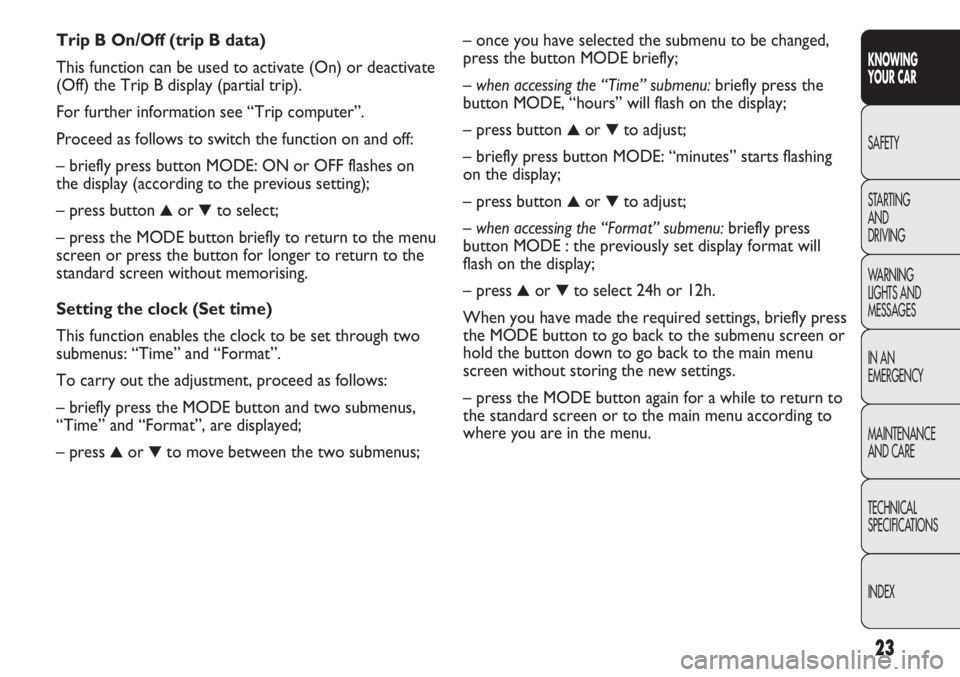
23
KNOWING
YOUR CAR
SAFETY
STARTING
AND
DRIVING
WARNING
LIGHTS AND
MESSAGES
IN AN
EMERGENCY
MAINTENANCE
AND CARE
TECHNICAL
SPECIFICATIONS
INDEX
– once you have selected the submenu to be changed,
press the button MODE briefly;
– when accessing the “Time” submenu:briefly press the
button MODE, “hours” will flash on the display;
– press button
▲or ▼to adjust;
– briefly press button MODE: “minutes” starts flashing
on the display;
– press button
▲or ▼to adjust;
– when accessing the “Format” submenu:briefly press
button MODE : the previously set display format will
flash on the display;
– press
▲or ▼to select 24h or 12h.
When you have made the required settings, briefly press
the MODE button to go back to the submenu screen or
hold the button down to go back to the main menu
screen without storing the new settings.
– press the MODE button again for a while to return to
the standard screen or to the main menu according to
where you are in the menu. Trip B On/Off (trip B data)
This function can be used to activate (On) or deactivate
(Off) the Trip B display (partial trip).
For further information see “Trip computer”.
Proceed as follows to switch the function on and off:
– briefly press button MODE: ON or OFF flashes on
the display (according to the previous setting);
– press button
▲or ▼to select;
– press the MODE button briefly to return to the menu
screen or press the button for longer to return to the
standard screen without memorising.
Setting the clock (Set time)
This function enables the clock to be set through two
submenus: “Time” and “Format”.
To carry out the adjustment, proceed as follows:
– briefly press the MODE button and two submenus,
“Time” and “Format”, are displayed;
– press
▲or ▼to move between the two submenus;
Page 28 of 287
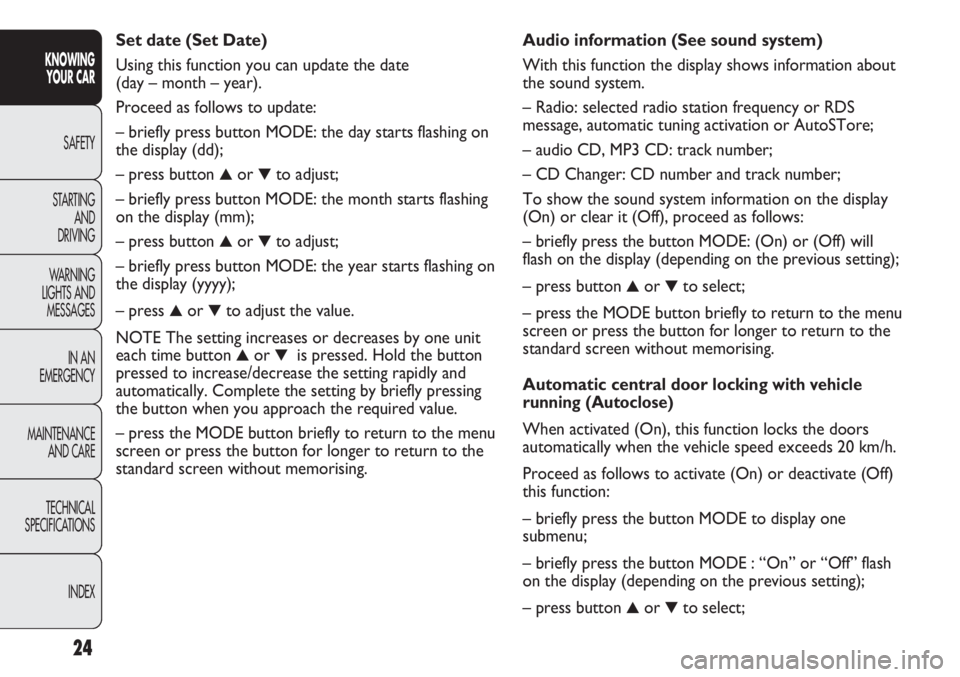
Audio information (See sound system)
With this function the display shows information about
the sound system.
– Radio: selected radio station frequency or RDS
message, automatic tuning activation or AutoSTore;
– audio CD, MP3 CD: track number;
– CD Changer: CD number and track number;
To show the sound system information on the display
(On) or clear it (Off), proceed as follows:
– briefly press the button MODE: (On) or (Off) will
flash on the display (depending on the previous setting);
– press button
▲or ▼to select;
– press the MODE button briefly to return to the menu
screen or press the button for longer to return to the
standard screen without memorising.
Automatic central door locking
with vehicle
running (Autoclose)
When activated (On), this function locks the doors
automatically when the vehicle speed exceeds 20 km/h.
Proceed as follows to activate (On) or deactivate (Off)
this function:
– briefly press the button MODE to display one
submenu;
– briefly press the button MODE : “On” or “Off” flash
on the display (depending on the previous setting);
– press button
▲or ▼to select; Set date (Set Date)
Using this function you can update the date
(day – month – year).
Proceed as follows to update:
– briefly press button MODE: the day starts flashing on
the display (dd);
– press button
▲or ▼to adjust;
– briefly press button MODE: the month starts flashing
on the display (mm);
– press button
▲or ▼to adjust;
– briefly press button MODE: the year starts flashing on
the display (yyyy);
– press
▲or ▼to adjust the value.
NOTE The setting increases or decreases by one unit
each time button
▲or ▼is pressed. Hold the button
pressed to increase/decrease the setting rapidly and
automatically. Complete the setting by briefly pressing
the button when you approach the required value.
– press the MODE button briefly to return to the menu
screen or press the button for longer to return to the
standard screen without memorising.
24
KNOWING
YOUR CAR
SAFETY
STARTING
AND
DRIVING
WARNING
LIGHTS AND
MESSAGES
IN AN
EMERGENCY
MAINTENANCE
AND CARE
TECHNICAL
SPECIFICATIONS
INDEX
Page 29 of 287
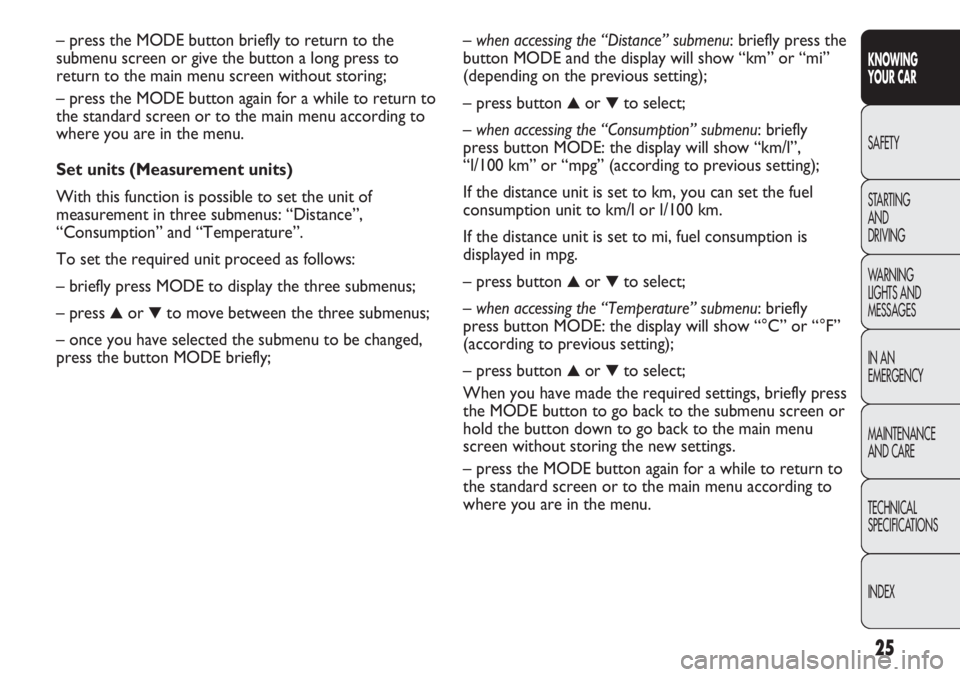
25
KNOWING
YOUR CAR
SAFETY
STARTING
AND
DRIVING
WARNING
LIGHTS AND
MESSAGES
IN AN
EMERGENCY
MAINTENANCE
AND CARE
TECHNICAL
SPECIFICATIONS
INDEX
– when accessing the “Distance” submenu: briefly press the
button MODE and the display will show “km” or “mi”
(depending on the previous setting);
– press button
▲or ▼to select;
– when accessing the “Consumption” submenu: briefly
press button MODE: the display will show “km/l”,
“l/100 km” or “mpg” (according to previous setting);
If the distance unit is set to km, you can set the fuel
consumption unit to km/l or l/100 km.
If the distance unit is set to mi, fuel consumption is
displayed in mpg.
– press button
▲or ▼to select;
– when accessing the “Temperature” submenu: briefly
press button MODE: the display will show “°C” or “°F”
(according to previous setting);
– press button
▲or ▼to select;
When you have made the required settings, briefly press
the MODE button to go back to the submenu screen or
hold the button down to go back to the main menu
screen without storing the new settings.
– press the MODE button again for a while to return to
the standard screen or to the main menu according to
where you are in the menu. – press the MODE button briefly to return to the
submenu screen or give the button a long press to
return to the main menu screen without storing;
– press the MODE button again for a while to return to
the standard screen or to the main menu according to
where you are in the menu.
Set units (Measurement units)
With this function is possible to set the unit of
measurement in three submenus: “Distance”,
“Consumption” and “Temperature”.
To set the required unit proceed as follows:
– briefly press MODE to display the three submenus;
– press
▲or ▼to move between the three submenus;
– once you have selected the submenu to be changed,
press the button MODE briefly;
Page 30 of 287
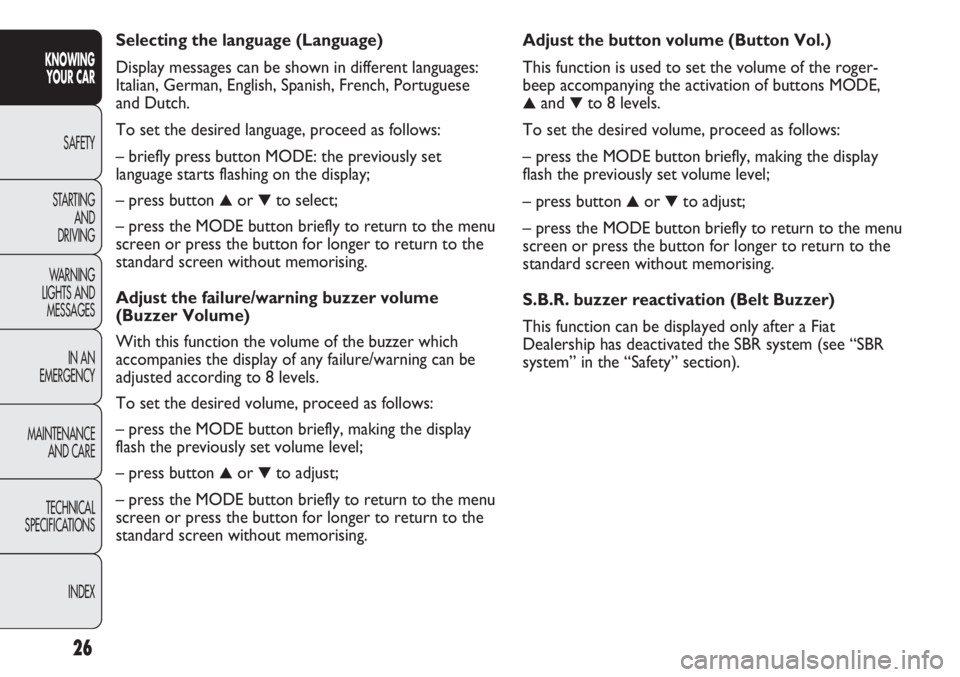
Adjust the button volume (Button Vol.)
This function is used to set the volume of the roger-
beep accompanying the activation of buttons MODE,
▲and ▼to 8 levels.
To set the desired volume, proceed as follows:
– press the MODE button briefly, making the display
flash the previously set volume level;
– press button
▲or ▼to adjust;
– press the MODE button briefly to return to the menu
screen or press the button for longer to return to the
standard screen without memorising.
S.B.R. buzzer reactivation (Belt Buzzer)
This function can be displayed only after a Fiat
Dealership has deactivated the SBR system (see “SBR
system” in the “Safety” section). Selecting the language (Language)
Display messages can be shown in different languages:
Italian, German, English, Spanish, French, Portuguese
and Dutch.
To set the desired language, proceed as follows:
– briefly press button MODE: the previously set
language starts flashing on the display;
– press button ▲or ▼to select;
– press the MODE button briefly to return to the menu
screen or press the button for longer to return to the
standard screen without memorising.
Adjust the failure/warning buzzer volume
(Buzzer Volume)
With this function the volume of the buzzer which
accompanies the display of any failure/warning can be
adjusted according to 8 levels.
To set the desired volume, proceed as follows:
– press the MODE button briefly, making the display
flash the previously set volume level;
– press button
▲or ▼to adjust;
– press the MODE button briefly to return to the menu
screen or press the button for longer to return to the
standard screen without memorising.
26
KNOWING
YOUR CAR
SAFETY
STARTING
AND
DRIVING
WARNING
LIGHTS AND
MESSAGES
IN AN
EMERGENCY
MAINTENANCE
AND CARE
TECHNICAL
SPECIFICATIONS
INDEX
Page 31 of 287
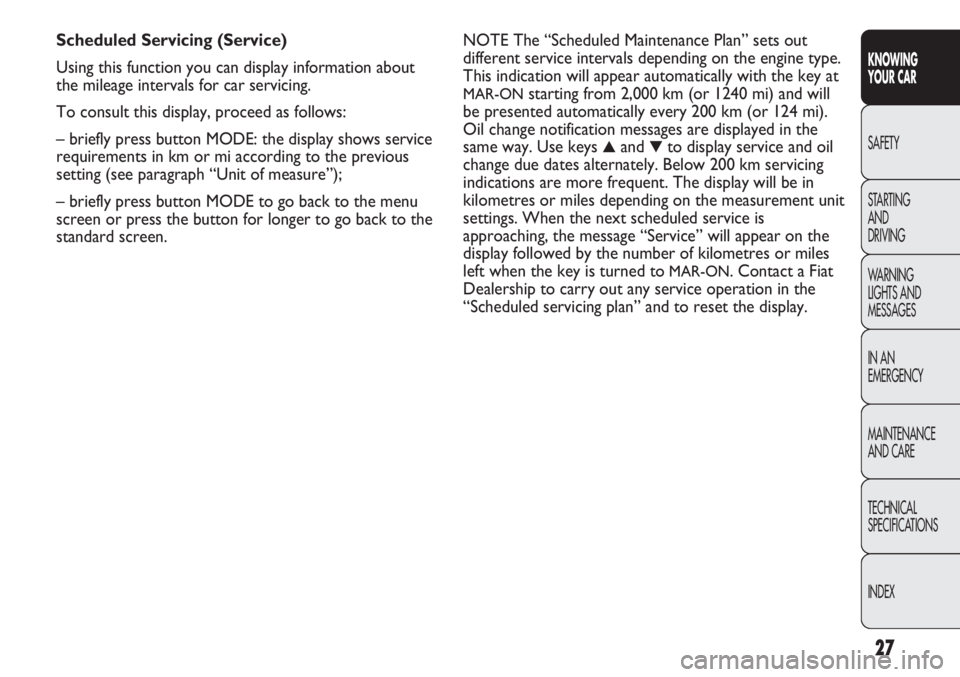
27
KNOWING
YOUR CAR
SAFETY
STARTING
AND
DRIVING
WARNING
LIGHTS AND
MESSAGES
IN AN
EMERGENCY
MAINTENANCE
AND CARE
TECHNICAL
SPECIFICATIONS
INDEX
NOTE The “Scheduled Maintenance Plan” sets out
different service intervals depending on the engine type.
This indication will appear automatically with the key at
MAR-ONstarting from 2,000 km (or 1240 mi) and will
be presented automatically every 200 km (or 124 mi).
Oil change notification messages are displayed in the
same way. Use keys
▲and ▼to display service and oil
change due dates alternately. Below 200 km servicing
indications are more frequent. The display will be in
kilometres or miles depending on the measurement unit
settings. When the next scheduled service is
approaching, the message “Service” will appear on the
display followed by the number of kilometres or miles
left when the key is turned to
MAR-ON. Contact a Fiat
Dealership to carry out any service operation in the
“Scheduled servicing plan” and to reset the display. Scheduled Servicing (Service)
Using this function you can display information about
the mileage intervals for car servicing.
To consult this display, proceed as follows:
– briefly press button MODE: the display shows service
requirements in km or mi according to the previous
setting (see paragraph “Unit of measure”);
– briefly press button MODE to go back to the menu
screen or press the button for longer to go back to the
standard screen.
Page 32 of 287
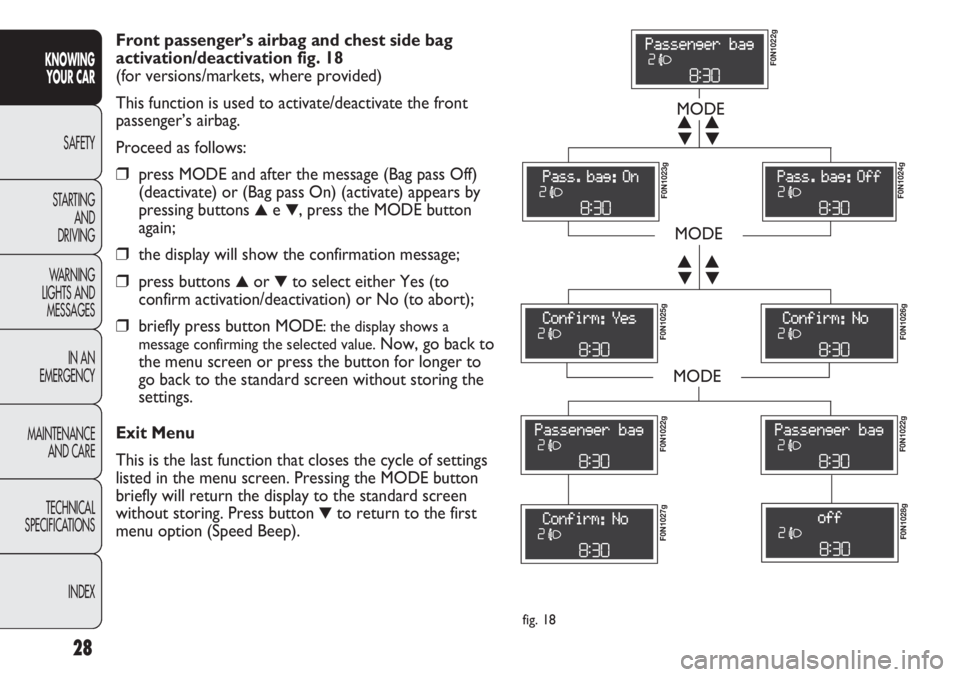
28
KNOWING
YOUR CAR
SAFETY
STARTING
AND
DRIVING
WARNING
LIGHTS AND
MESSAGES
IN AN
EMERGENCY
MAINTENANCE
AND CARE
TECHNICAL
SPECIFICATIONS
INDEX
MODE
MODE
MODE
▼ ▲
▼ ▲
▼ ▲
▼ ▲
F0N1022g F0N1023g
F0N1024g F0N1025g
F0N1026g F0N1022gF0N1022g
F0N1027gF0N1028g
Front passenger’s airbag and chest side bag
activation/deactivation fig. 18
(for versions/markets, where provided)
This function is used to activate/deactivate the front
passenger’s airbag.
Proceed as follows:
❒press MODE and after the message (Bag pass Off)
(deactivate) or (Bag pass On) (activate) appears by
pressing buttons
▲e ▼, press the MODE button
again;
❒the display will show the confirmation message;
❒press buttons ▲or ▼to select either Yes (to
confirm activation/deactivation) or No (to abort);
❒briefly press button MODE: the display shows a
message confirming the selected value.
Now, go back to
the menu screen or press the button for longer to
go back to the standard screen without storing the
settings.
Exit Menu
This is the last function that closes the cycle of settings
listed in the menu screen. Pressing the MODE button
briefly will return the display to the standard screen
without storing. Press button
▼to return to the first
menu option (Speed Beep).
fig. 18
Page 33 of 287
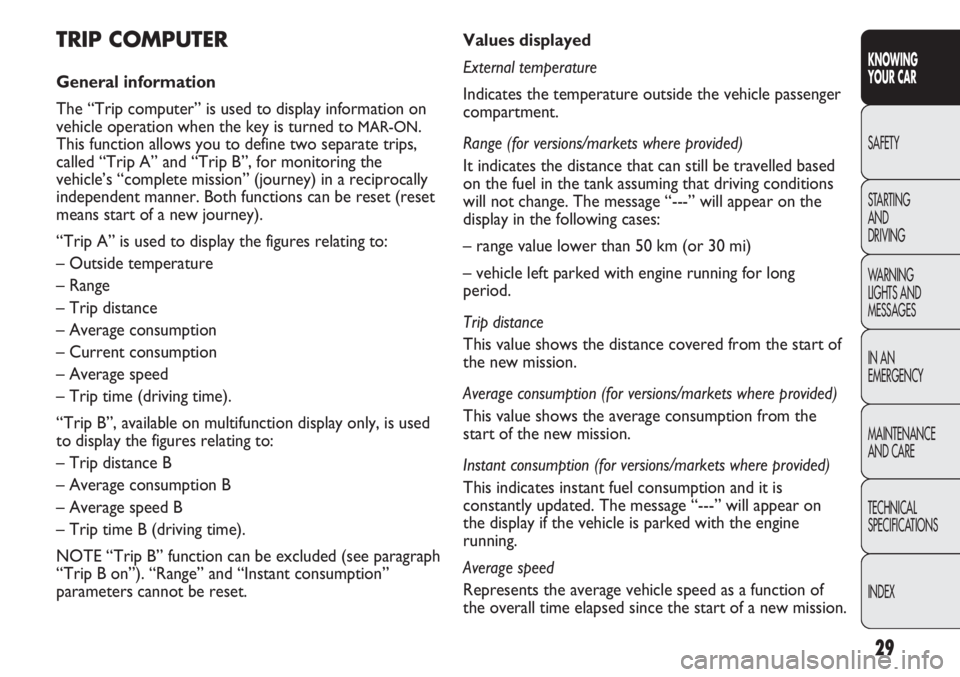
29
KNOWING
YOUR CAR
SAFETY
STARTING
AND
DRIVING
WARNING
LIGHTS AND
MESSAGES
IN AN
EMERGENCY
MAINTENANCE
AND CARE
TECHNICAL
SPECIFICATIONS
INDEX
Values displayed
External temperature
Indicates the temperature outside the vehicle passenger
compartment.
Range (for versions/markets where provided)
It indicates the distance that can still be travelled based
on the fuel in the tank assuming that driving conditions
will not change. The message “---” will appear on the
display in the following cases:
– range value lower than 50 km (or 30 mi)
– vehicle left parked with engine running for long
period.
Trip distance
This value shows the distance covered from the start of
the new mission.
Average consumption (for versions/markets where provided)
This value shows the average consumption from the
start of the new mission.
Instant consumption (for versions/markets where provided)
This indicates instant fuel consumption and it is
constantly updated. The message “---” will appear on
the display if the vehicle is parked with the engine
running.
Average speed
Represents the average vehicle speed as a function of
the overall time elapsed since the start of a new mission.TRIP COMPUTER
General information
The “Trip computer” is used to display information on
vehicle operation when the key is turned to
MAR-ON.
This function allows you to define two separate trips,
called “Trip A” and “Trip B”, for monitoring the
vehicle’s “complete mission” (journey) in a reciprocally
independent manner. Both functions can be reset (reset
means start of a new journey).
“Trip A” is used to display the figures relating to:
– Outside temperature
– Range
– Trip distance
– Average consumption
– Current consumption
– Average speed
– Trip time (driving time).
“Trip B”, available on multifunction display only, is used
to display the figures relating to:
– Trip distance B
– Average consumption B
– Average speed B
– Trip time B (driving time).
NOTE “Trip B” function can be excluded (see paragraph
“Trip B on”). “Range” and “Instant consumption”
parameters cannot be reset.
Page 34 of 287
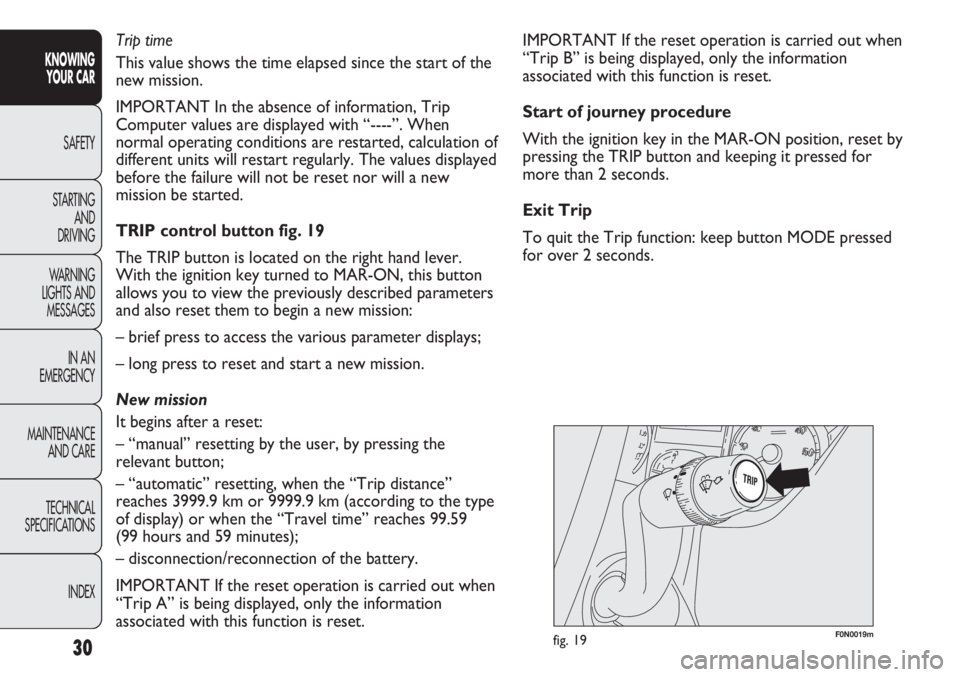
F0N0019mfig. 19
IMPORTANT If the reset operation is carried out when
“Trip B” is being displayed, only the information
associated with this function is reset.
Start of journey procedure
With the ignition key in the MAR-ON position, reset by
pressing the TRIP button and keeping it pressed for
more than 2 seconds.
Exit Trip
To quit the Trip function: keep button MODE pressed
for over 2 seconds. Trip time
This value shows the time elapsed since the start of the
new mission.
IMPORTANT In the absence of information, Trip
Computer values are displayed with “----”. When
normal operating conditions are restarted, calculation of
different units will restart regularly. The values displayed
before the failure will not be reset nor will a new
mission be started.
TRIP control button fig. 19
The TRIP button is located on the right hand lever.
With the ignition key turned to MAR-ON, this button
allows you to view the previously described parameters
and also reset them to begin a new mission:
– brief press to access the various parameter displays;
– long press to reset and start a new mission.
New mission
It begins after a reset:
– “manual” resetting by the user, by pressing the
relevant button;
– “automatic” resetting, when the “Trip distance”
reaches 3999.9 km or 9999.9 km (according to the type
of display) or when the “Travel time” reaches 99.59
(99 hours and 59 minutes);
– disconnection/reconnection of the battery.
IMPORTANT If the reset operation is carried out when
“Trip A” is being displayed, only the information
associated with this function is reset.
30
KNOWING
YOUR CAR
SAFETY
STARTING
AND
DRIVING
WARNING
LIGHTS AND
MESSAGES
IN AN
EMERGENCY
MAINTENANCE
AND CARE
TECHNICAL
SPECIFICATIONS
INDEX
Page 35 of 287
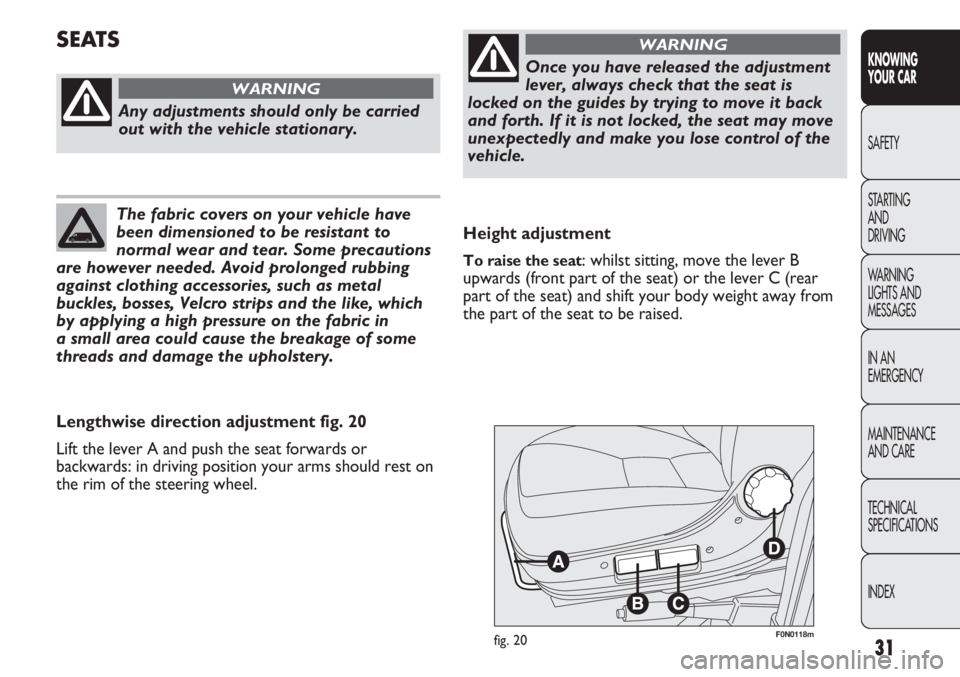
31
KNOWING
YOUR CAR
SAFETY
STARTING
AND
DRIVING
WARNING
LIGHTS AND
MESSAGES
IN AN
EMERGENCY
MAINTENANCE
AND CARE
TECHNICAL
SPECIFICATIONS
INDEX
F0N0118mfig. 20
Height adjustment
To raise the seat: whilst sitting, move the lever B
upwards (front part of the seat) or the lever C (rear
part of the seat) and shift your body weight away from
the part of the seat to be raised.
SEATS
Any adjustments should only be carried
out with the vehicle stationary.
WARNING
The fabric covers on your vehicle have
been dimensioned to be resistant to
normal wear and tear. Some precautions
are however needed. Avoid prolonged rubbing
against clothing accessories, such as metal
buckles, bosses, Velcro strips and the like, which
by applying a high pressure on the fabric in
a small area could cause the breakage of some
threads and damage the upholstery.
Lengthwise direction adjustment fig. 20
Lift the lever A and push the seat forwards or
backwards: in driving position your arms should rest on
the rim of the steering wheel.
Once you have released the adjustment
lever, always check that the seat is
locked on the guides by trying to move it back
and forth. If it is not locked, the seat may move
unexpectedly and make you lose control of the
vehicle.
WARNING
Page 36 of 287
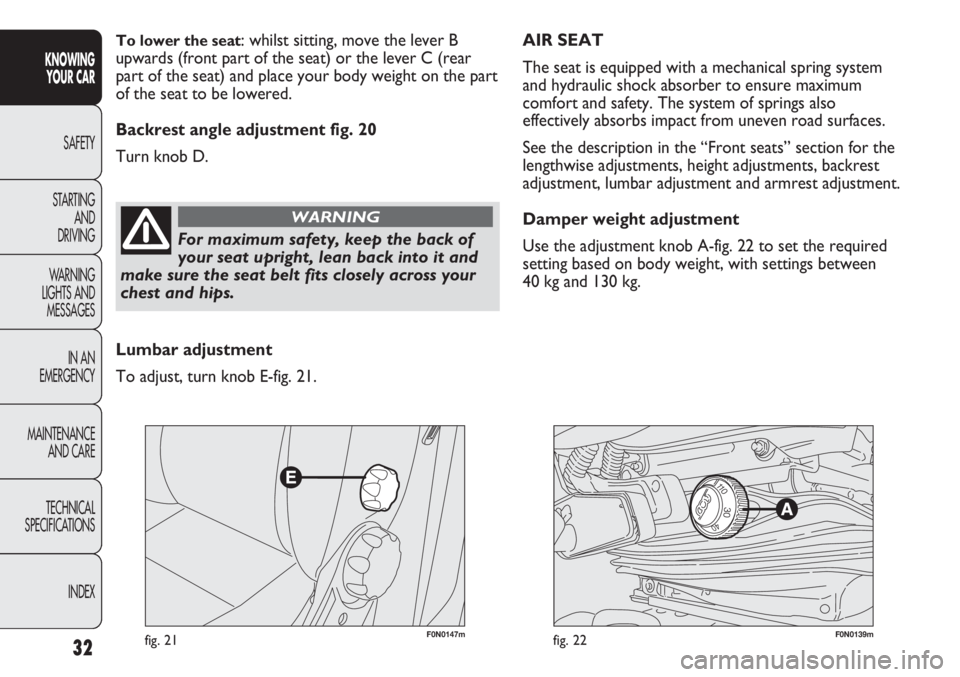
32
KNOWING
YOUR CAR
SAFETY
STARTING
AND
DRIVING
WARNING
LIGHTS AND
MESSAGES
IN AN
EMERGENCY
MAINTENANCE
AND CARE
TECHNICAL
SPECIFICATIONS
INDEX
F0N0147mfig. 21F0N0139mfig. 22
AIR SEAT
The seat is equipped with a mechanical spring system
and hydraulic shock absorber to ensure maximum
comfort and safety. The system of springs also
effectively absorbs impact from uneven road surfaces.
See the description in the “Front seats” section for the
lengthwise adjustments, height adjustments, backrest
adjustment, lumbar adjustment and armrest adjustment.
Damper weight adjustment
Use the adjustment knob A-fig. 22 to set the required
setting based on body weight, with settings between
40 kg and 130 kg.To lower the seat: whilst sitting, move the lever B
upwards (front part of the seat) or the lever C (rear
part of the seat) and place your body weight on the part
of the seat to be lowered.
Backrest angle adjustment fig. 20
Turn knob D.
For maximum safety, keep the back of
your seat upright, lean back into it and
make sure the seat belt fits closely across your
chest and hips.
WARNING
Lumbar adjustment
To adjust, turn knob E-fig. 21.